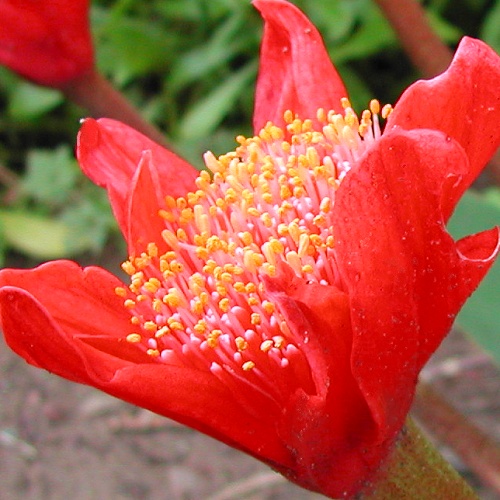Germinating the seeds
» Your seeds should be planted the day you receive them Getting started -- Rinse the seeds in plain water. Be careful not to drop them down the drain! You may plant them individual pots about 3 inches (8 cm) wide with drainage holes. The pot will hold the plant the first year. You may instead plant the seeds in a single pot, but if any bulbs go dormant before the rest, you should remove them. If you choose to use a single pot, use one wide enough so each seed is 1.5 inches (3 cm) from the next and from the pot wall. Fill with a very well-draining mix, such
as 1 part potting soil to 1 part
perlite The best germination temperature is about 66-79° F (19-26°C) during the day. A little cooler at night is ok. Avoid
letting them get above 80° F (27°C) for prolonged periods. I recommend placing a
minimum/maximum thermometer If you enclose the pot in a plastic container or bag to maintain moisture, leave it open slightly for fresh air to enter. You may need to drip some water around the seeds periodically to keep them moist. Keep them in bright light out of direct sun. An LED lamp placed 4 inches (10 cm) away provides the right amount of light (See: "Growing indoors with LED lights"). The seeds will first grow a root, followed by a leaf about 2-4 weeks later. They tend to sprout at different times, with most of them sprouting between 1 and 3 months. Occasionally they can take longer, so as long as the seeds are firm, don't give up on them! Once they sprout, continue giving bright light, with no direct sun the first few months, unless it's weak sun. If the seed happens to pop up out of the soil, add a little soil around it so it's mostly buried. Fertilizing -- Once the first leaf appears, give a small amount of dilute (1/8 strength) liquid fertilizer. Hydroponic fertilizer is ideal for young seedlings, since it is easily absorbed and contains all essential nutrients. Repeat this once a month for 3 months. Watering -- Aim to keep the soil evenly moist, but not saturated. Light -- Once they're a few months old, you can give them some direct sun if it's weak. Increase the sun a little each week, watching for possible burning. The don't need lots of sun, but a few hours helps. Shade them from strong afternoon sun the first 2 years. Dormancy -- The bulbs normally go dormant for the summer, but young seedlings might continue to grow through summer if grown indoors. If the foliage turns yellow in late spring, reduce the watering since the bulb is preparing for dormancy. Once dormant, keep the soil slightly damp throughout summer, but not wetter than this. You may repot during this time to a pot about 4 inches (10 cm) wide, which will hold it for 2 years. Soil -- You can repot using the same soil mix described above. Leave the top part of the bulb exposed. As the bulb grows bigger each year, more of it can remain exposed. Growing onward.. Climate -- They should be kept below about 85°F (29°C) during the growing season of early autumn through mid-spring (October to May in the northern hemisphere). While they are young, keep them from freezing. Older plants are said to tolerate a light frost, but it's best to protect them from frost. General info on the plant is here. If you have questions, feel free to contact me. Have fun growing them! - Jeff Strange Wonderful Things
|
|||||||||


